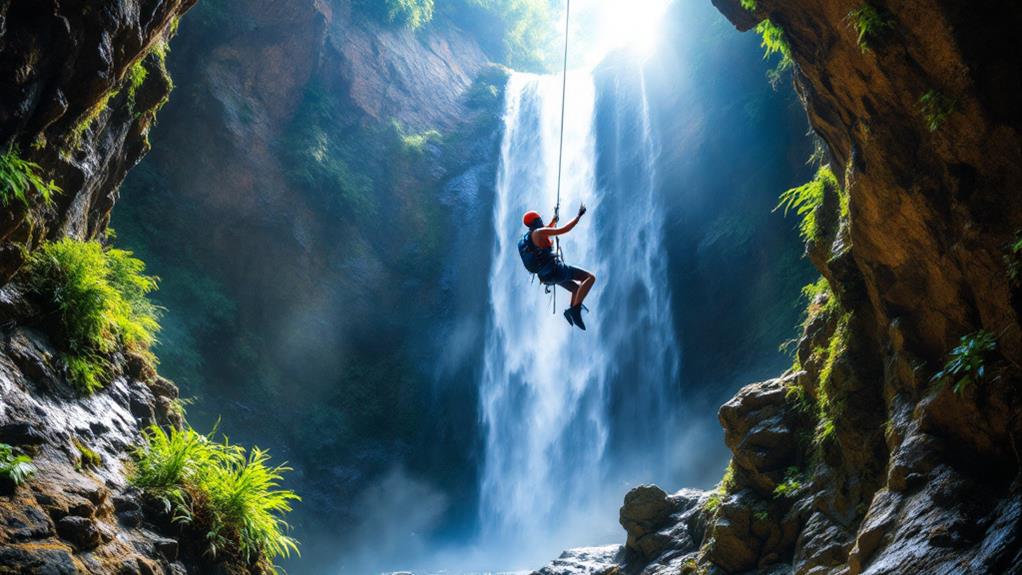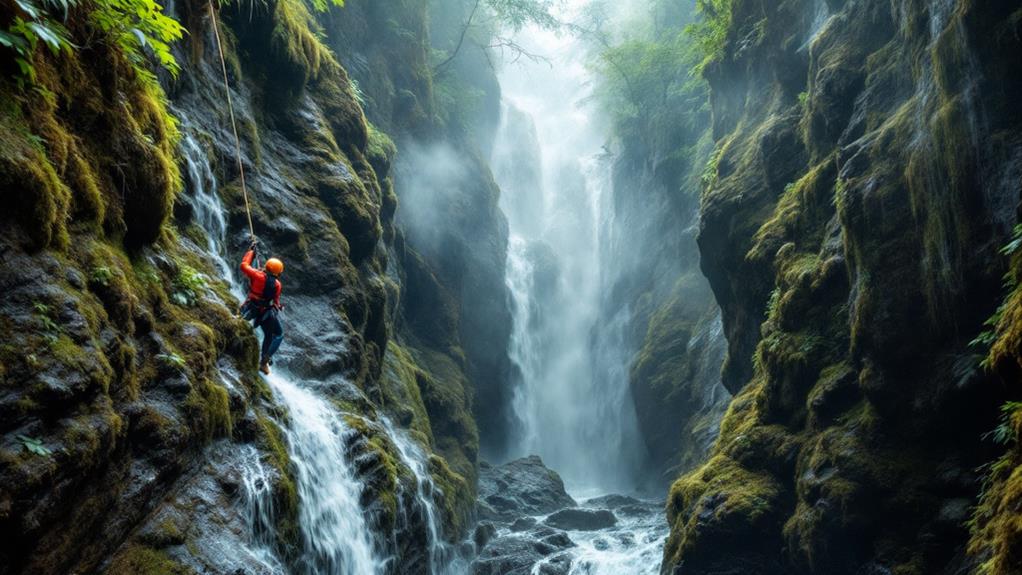How Difficult Is Canyoning?

Canyoning presents a significant challenge, testing your physical and mental limits. You'll need a combination of strength, endurance, and agility to navigate steep descents, rock climbs, and swift water currents. Technical skills like rappelling, water safety, and navigation are crucial. Environmental factors, including weather and terrain, add complexity and risk. The difficulty level ranges from beginner-friendly routes to advanced expeditions requiring extensive experience. Proper training, equipment, and safety precautions are essential. As you progress, you'll face increasingly demanding obstacles and decision-making scenarios. Understanding the full scope of canyoning's challenges will help you prepare for this thrilling adventure.
Physical Demands of Canyoning
How physically demanding is canyoning? It's a challenging outdoor activity that requires a combination of strength, endurance, and agility. You'll need to be prepared for hiking, climbing, swimming, and rappelling, often in rugged terrain and cold water.
Upper body strength is crucial for pulling yourself up rock faces and controlling your descent during rappels. Lower body strength helps with hiking and jumping between rocks. Core strength is essential for maintaining balance and stability throughout the journey.
Cardiovascular endurance is vital, as canyoning trips can last several hours or even full days. You'll be constantly moving, navigating obstacles, and battling currents in water-filled canyons.
Flexibility and agility are important for squeezing through tight spaces and maneuvering over uneven surfaces. Good balance is necessary for traversing slippery rocks and narrow ledges.
The physical demands can vary depending on the difficulty of the canyon. Beginner routes may be less strenuous, while advanced canyons can push even experienced athletes to their limits. It's important to honestly assess your fitness level and choose a route that matches your abilities to ensure a safe and enjoyable experience.
Technical Skills Required
Beyond physical fitness, canyoning demands a specific set of technical skills. You'll need to master rope techniques, including rappelling and belaying. These skills are crucial for safely descending waterfalls and navigating steep rock faces. You must learn to tie various knots, set up anchors, and manage your equipment effectively.
Water safety is another critical skill. You'll encounter swift currents, deep pools, and potentially dangerous water features. Understanding how to read water flow, swim in rapids, and perform swift water rescues is essential. You should also be proficient in assessing risks and making quick decisions in challenging environments.
Navigation skills are vital, as you'll often be in remote areas with limited visibility. You must be able to read topographic maps, use a compass, and identify landmarks to stay on course. Additionally, you'll need to develop rock climbing techniques for scrambling over boulders and traversing narrow ledges.
Weather interpretation is crucial too. You should understand how quickly conditions can change in canyons and how to respond appropriately. Lastly, first aid knowledge is indispensable for handling potential injuries or emergencies in these isolated settings.
Environmental Factors

When you're out canyoning, you'll encounter a variety of environmental factors that can significantly impact your experience and safety. Weather conditions play a crucial role, as sudden rainstorms can lead to flash floods, making canyons dangerous or impassable. You'll need to monitor forecasts and be prepared to adjust your plans accordingly.
Water temperature and flow rate are also critical factors. Cold water can lead to hypothermia, while strong currents increase the risk of accidents. You'll have to assess these conditions and use appropriate gear, such as wetsuits or dry suits.
The canyon's terrain presents its own challenges:
| Terrain Type | Difficulty Level | Safety Considerations |
|---|---|---|
| Smooth Rock | Moderate | Slippery when wet |
| Loose Gravel | High | Unstable footing |
| Steep Drops | Extreme | Proper rope techniques |
You'll need to navigate these varying surfaces while managing fatigue and maintaining situational awareness. Additionally, you'll encounter flora and fauna unique to each canyon environment. Some plants may be poisonous or cause skin irritation, while certain animals could pose a threat if disturbed. Understanding and respecting the ecosystem you're exploring is essential for a safe and enjoyable canyoning experience.
Experience Levels and Progression
Canyoning experience levels typically fall into three main categories: beginner, intermediate, and advanced. As a beginner, you'll start with easy canyons that have minimal technical challenges. These routes often involve hiking, scrambling, and basic rope work. You'll learn essential skills like rappelling, water safety, and navigation. Canyoning is known by different names in various regions, such as "canyoneering" in the U.S. and "kloofing" in South Africa.
As you progress to the intermediate level, you'll tackle more challenging canyons with longer rappels, swims, and jumps. You'll encounter a variety of obstacles and need to make decisions about route-finding and risk assessment. At this stage, you'll refine your techniques and build confidence in your abilities.
Advanced canyoners take on the most difficult routes, which may include multi-day expeditions, complex rope systems, and exposed climbs. You'll need to master advanced techniques like rope rescue, anchor building, and swift water navigation. At this level, you'll also develop leadership skills and the ability to guide others.
To progress through these levels, you should seek proper training, join experienced groups, and gradually increase the difficulty of your canyoning trips. Always prioritize safety and be honest about your skill level when choosing routes.
Safety Considerations

Considering the inherent risks involved, safety should be your top priority in canyoning. Always wear appropriate gear, including a helmet, wetsuit, and sturdy footwear with good grip. Use a harness and rope system for rappelling and climbing sections. It's crucial to check weather conditions before your trip, as flash floods can be extremely dangerous in canyons.
Never go canyoning alone. Always have an experienced guide or join a reputable tour group, especially if you're a beginner. They'll ensure you're using proper techniques and equipment. Learn and practice basic first aid skills, as medical help may be far away in remote canyons. When diving in ice, it's crucial to be certified by the American Academy of Underwater Sciences (AAUS) and have experience with cold-water diving and dry suits.
Be aware of your surroundings and potential hazards like loose rocks, slippery surfaces, and deep water. Don't jump into pools without checking the depth and for hidden obstacles. Communicate clearly with your group using pre-established hand signals. Carry emergency supplies, including a first aid kit, extra food, and a means of communication. Stay within your skill level and don't push yourself beyond your limits. Remember, canyoning can be risky, but proper precautions significantly reduce the dangers.
Equipment and Preparation
Proper equipment and thorough preparation are essential for a safe and enjoyable canyoning experience. You'll need a wetsuit, helmet, harness, and sturdy footwear with good grip. Don't forget a dry bag for your personal items and emergency supplies. Invest in a quality rope, carabiners, and descending devices suitable for canyoning.
Before your trip, research the canyon you'll be exploring. Understand its difficulty level, water conditions, and potential hazards. Check the weather forecast, as sudden changes can dramatically impact water levels and safety. Ensure you have the necessary skills and experience for the chosen route. If you're a beginner, consider joining a guided tour or taking a canyoning course.
Physical preparation is crucial. Build your strength, endurance, and flexibility through regular exercise. Practice rope techniques and swimming in various conditions. Familiarize yourself with the equipment and how to use it properly. Pack enough food, water, and first aid supplies for the duration of your trip. Always inform someone of your plans and expected return time. By thoroughly preparing and equipping yourself, you'll be better positioned to handle the challenges of canyoning.
